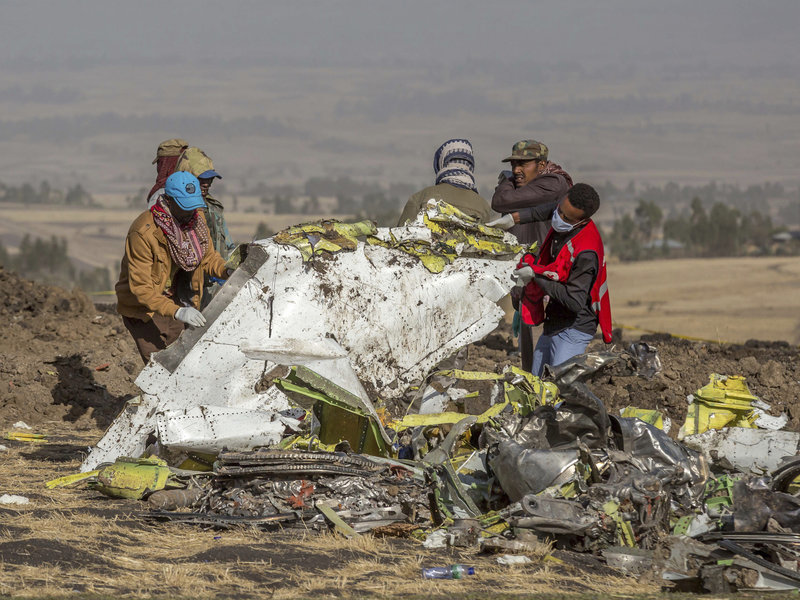Estimated reading time 5 minutes, 52 seconds.
The Ethiopian Aircraft Accident Investigation Bureau (AIB) released its interim report on the crash of Ethiopian Airlines Flight 302 (ET 302), citing inadequate training provided by Boeing and the activation of the Maneuvering Characteristics Augmentation System (MCAS) as the principal causes of the crash.

Ethiopian Flight 302, a Boeing 737 Max 8 aircraft, crashed on March 10, 2019 shortly after taking off from Addis Ababa Bole International Airport in the Ethiopian capital, killing 157 people on board. The accident occurred only five months after a 737 Max operated by Indonesian airline Lion Air crashed under similar circumstances, resulting in the loss of 189 people aboard that aircraft.
After the Ethiopian crash, aviation regulatory bodies the world over banned the Max from their airspace, eventually resulting in the grounding of the type.
The release of the interim accident investigation report came a day before the one-year anniversary of the crash of the Egypt-bound flight. In it, the AIB found that the 737 Max aircraft had “a valid certificate of airworthiness and [had been] maintained in accordance with applicable regulations and procedures,” had no technical problems before departure, and the aircraft weight and balance was within the operating limits.
This differed slightly from Indonesia’s final crash report on the Lion Air crash, which cited a number of factors that included the aircraft’s design along with the crew’s response and a lack of documentation on the aircraft’s flight and maintenance histories as the causes of the accident.
This latest report from Ethiopia details an almost second-by-second account of the harrowing moments between ET 302’s taxi to the runway and its impact with terrain.
During the flight, as was the case in the Lion Air crash, the MCAS played a major role. The system was designed to lower the nose of the plane if sensors told it that the angle of attack (AOA) was too high – which could cause the aircraft to stall.
The information fed to the MCAS was wrong on both flights.

The AIB found Flight 302’s left and right AOA sensors differed by 59 degrees, causing the MCAS to push the nose of the plane downwards. As a result of this, at one point “the pitch angle dropped from 0.5 degrees nose up to -7.8 degrees nose down,” resulting in the rate of descent increasing from 100 feet per minute to over 5,000 feet per minute.
The report stated that the pilots recognized the fault and disengaged the MCAS, attempting to manually regain control and pitch the nose back up. But “approximately five seconds after the last manual electric trim up input, a fourth automatic trim nose-down (MCAS) triggered.”
The fourth adjustment made by the MCAS sent the 737 Max 8 into a dive from which the pilots were unable to recover.
At the time of the crash, the plane was pointing down at a 40-degree angle and travelling at a speed of more than 500 feet per second, according to the report.
The document did not cite pilot error as the cause, although it did say that the crew turned the MCAS back on after it repeatedly pointed the aircraft’s nose down during takeoff and ascent. Rather, the report stated that “the difference [in] training from B737NG to B737 MAX provided by the manufacturer was found to be inadequate.”
The AIB made a number of recommendations as Boeing continues its work to return the 737 Max family to the air. These include a redesign of the MCAS and increased training for pilots who fly the aircraft – citing the need for simulator sessions to familiarize pilots with “normal and non-normal MCAS operation.” Boeing originally claimed pilots wouldn’t need simulator training to transition to the Max, but reversed their stance in January of this year.
The fallout from the crashes has been significant for Boeing, leading to the firing of CEO Dennis Muilenburg in December 2019, who had been in the role for over four years at the time. The company has also halted production of the Max as it works towards the aircraft’s recertification, which has contributed to the US$19 billion loss the company has seen as a result of the two crashes, leading to its first annual loss in over two decades.
As if the release of the damning report wasn’t enough, Boeing announced on March 9 that an employee at its Everett, Wash., facility had contracted COVID-19, leading to the quarantine of that employee along with all of their co-workers.








